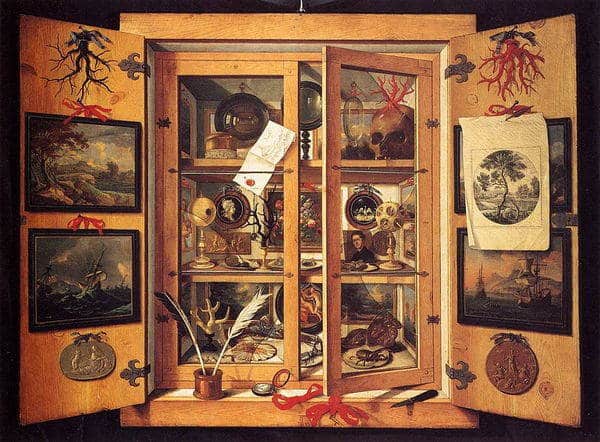
Famous cabinets of curiosities
Famous cabinets of curiosities

During the Italian Renaissance, the Medici’s cabinet of curiosities was one of the precursors in this field. In France, Bernard Palissy had a cabinet of curiosities, which he mentions in his discourse on the nature of waters and fountains in 1580: he had set it up in order to gather evidence that fossils were, according to him, animal debris. The famous cabinets of curiosity were born.

The Cabinet of Curiosities, Domenico Remps, 1690.
The “Kunst und Wunderkammer” of Archduke Ferdinand II (1529-1595) in Ambras Castle, Innsbruck, Austria, can still be visited today, making it the oldest museum in the world. The museum of Rudolf II of Habsburg in Prague Castle was the other richest and most famous, along with the Cabinet of Wonders in the Residence Castle in Dresden, which was established between 1723 and 1729, but which originally dates back to the Duke of Saxony (1521-1553).

Cabinet of art and curiosities, Frans Francken the Younger, 1636.

Meeting of foreign birds, Alexandre Isidore Leroy de Barde, late 18th century.
In France, François I (1494-1547) had his cabinet of curiosities in Fontainebleau with notably more than forty engravings of the flora and fauna of Amazonia. In the Tuileries palace, Henri IV (1553-1610) had a cabinet of curiosities, and enriched in Fontainebleau, that of François I. Many exotic plants, when they had resisted the trip, were replanted in the garden of the Louvre, making it the first garden of exotic botany.

Frontispice de Musei Wormiani Historia (1655) montrant l'intérieur du cabinet de curiosités de Worm.
In the middle of the tulipomania period, Louis XIV created a museum of exotic plants between Versailles and the King’s garden. Under Louis XV, Buffon created a cabinet in the King’s Garden, which later became the Jardin des plantes de Paris. The cabinet was enlarged and enriched by Lacépède, then Lamarck, who directed the publication of the Histoire Naturelle des poissons et des animaux. The collections of the king’s cabinet are the basis of the current collections of the National Museum of Natural History in Paris.

Cabinet of curiosity of Joseph Bonnier de la Mosson.
The first cabinet of curiosities in France was assembled by Réaumur.

Histoire Naturelle générale et particulière, Georges Louis Buffon.
Before Buffon, Réaumur (1683-1757) assembled the largest cabinet of curiosities in France, mainly devoted to animal species, in particular birds preserved in skin and then stuffed. Réaumur is best known for his work as a physicist and as the inventor of taxidermy. He was also very interested in entomology with his famous Mémoire pour servir l’histoire naturelle des insectes. At his death, Buffon succeeded in obtaining his collections and integrating them into the king’s cabinet.
In Russia, Peter the Great had his cabinet of curiosities, where he collected the remains of the strangest animals at the origin of the Museum of ethnography and zoology of the Russian Academy of Sciences.
Throughout the 18th century, the cabinets of curiosities, almost everywhere in Europe, are in constant expansion, including of course in France, where we have seen that Réaumur and Buffon had constituted for the king’s cabinet, the most beautiful and important collections of natural history (insects, birds, stuffed mammals, reptiles, fish, amphibians) in the world. In our country, this craze for curiosity cabinets, and therefore for natural history, but not only, was to come to a halt during the French Revolution. Curiosity existed mainly, indeed, outside the museum of the garden of plants, only through rich cabinets, whose owners, great lords, princes and dukes had fled France. It will only take off again with the restoration in the middle of the following century.

Sea plumes, lithophytes and shells, Anne France Allayer-Coster, 1769.

Museum of Natural History, Montreal.
As we have seen, the 19th century and the first half of the 20th century with the development and the constitution of our colonial empire, in Africa as well as in Indochina and a little in Guyana, allowed museums as well as private individuals, to acquire splendid collections of birds, mammals, shells and in Guyana of butterflies and insects.
Finally, we must mention here, the wall of curiosities of André Breton (1896-1966), reconstituted in the Pompidou Center, who with the surrealist movement, was going to give an artistic amplitude, to an accumulation of objects as heterogeneous as boxes of butterflies, stuffed birds, a shell of tortoise, paintings of Picabia and Miro, African masks, shields and papuan clubs or necklaces of shells. The accumulation and presentation on the wall of his office of these 212 ethnographic, zoological objects and works of art, results in an aestheticism that unites nature and cultures of the five continents.

André Breton's workshop.



